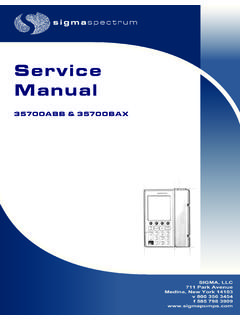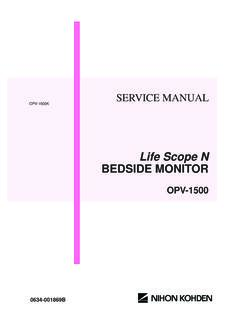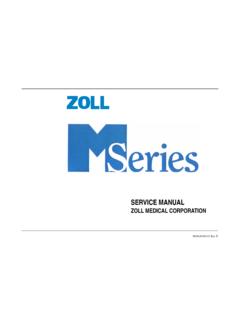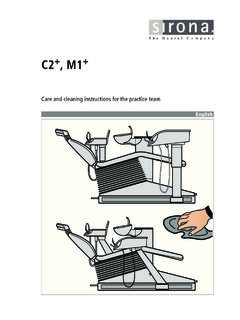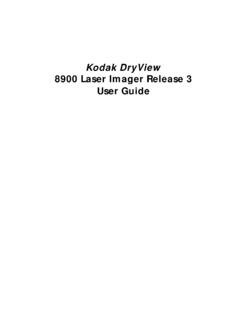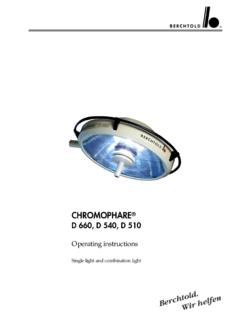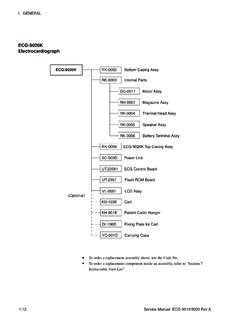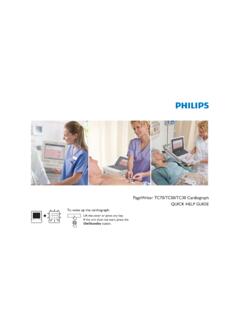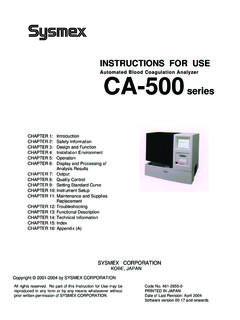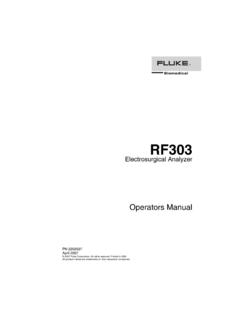Transcription of INSTRUCTIONS FOR USE Series 50 A - Frank's …
1 FETAL MONITORINGINSTRUCTIONS FOR USEO bstetrical CareSeries 50 AM1351 ASeries 50 IP-2M1353 AFetal/Maternal Monitors*M1353-9001K*Printed in Germany 07/04 Part Number M1353-9001K4512 610 04101 Series 50 A (M1351A) Series 50 IP-2 (M1353A)Fetal MonitorsINSTRUCTIONS FOR USEM1353-9001 KPrinted in GermanyJuly 2004 Philips makes no warranty of any kind with regard to this material, including, but not limited to, the implied warranties of merchantability and fitness for a particular purpose. Philips shall not be liable for errors contained herein or for incidental or consequential damages in connection with the furnishing, performance or use of this information contained in this document is subject to change without assumes no responsibility for the use or reliability of its software on equipment that is not furnished by of the ManufacturerPhilips only considers itself responsible for any effects on safety, reliability and performance of the equipment if.
2 Assembly operations, extensions, re-adjustments, modifications or repairs are carried out by persons authorized by Philips, and the electrical installation of the relevant room complies with national standards, and the instrument is used in accordance with the INSTRUCTIONS for Use or User s Use (M1351A)The intended use of this device is to monitor the condition of the fetus by measuring fetal heart rate (FHR), maternal uterine activity and optionally fetal movements M1531A is a fetal monitor designed for the antepartum testing area. The fetal heartbeat is detected by an ultrasound transmitter/receiver probe applied to the abdominal intended use of this device is to provide information of both FHR and maternal uterine activity on a digital display, on a strip chart recorder and on an interface for optional remote data Use (M1353A)The intended use of this device is to monitor the condition of the fetus by measuring fetal heart rate (FHR), maternal uterine activity and optionally fetal movements M1353A is a fetal monitor designed for the antepartum and intrapartum testing area.
3 The fetal heartbeat may be detected by ECG electrodes connected to the fetal scalp or by an ultrasound transmitter/receiver probe connected to the abdominal wall. The uterine pressure may be detected by a pressure probe connected to the intrauterine pressure via a fluid filled tube or by a pressure probe connected to the abdominal intended use of this device is to provide information of both FHR and maternal uterine activity on a digital display, on a strip chart recorder and on an interface for optional remote data monitor should only be used by, or under the direct supervision of, a licensed physician or other health care practitioner who is trained in the use of fetal and maternal heart rate monitors and in the interpretation of fetal and maternal heart rate traces. US law restricts this device to sale by, or on the order of, a Used in This GuideWarningA warning alerts you to a potential serious outcome, adverse event or safety hazard.
4 Failure to observe a warning may result in death or serious injury to the user or caution alerts you to situations where special care is necessary for the safe and effective use of the product. Failure to observe a caution may result in minor or moderate personal injury or damage to the product or other property, and possibly in a remote risk of more serious A note calls your attention to an important point in the text. 1990-2004 Koninklijke Philips Electronics Rights your monitor, this sign indicates that there is detailed information in this book which you must read before proceeding with your task. ContentsiContents1. Overview .. 1 Introduction .. 1 About This Guide.. 1 About the Monitors .. 2 Major Parts and Keys .. 5 Recorder Keys .. 5 Major Keys at a Glance .. 6 Display Panel .. 82. General Information.. 11 Introduction .. 11 Fastening a Belt around the Mother .. 11 Clipping a Transducer to the Belt.
5 12 Attaching a Patient Module to the Belt .. 13 Connecting a Transducer or Patient Module to the Monitor .. 13 Signal Quality .. 14 Suspected Fetal Demise .. 14 Marking an Event .. 15 After Monitoring .. 173. Getting Started .. 19 Introduction .. 19 Before Connecting to the Power Supply.. 19 Connecting to the Power Supply.. 20 Loading Paper .. 21 Paper-Out Alert.. 22 Choosing Paper Speed.. 22 Setting the Paper Speed.. 22 Tearing Off the Paper .. 23 Switching on the Recorder .. 23 Displaying the Time and Date .. 24 Setting the Time and Date .. 24 Mounting the Monitor .. 25 Fitting the Monitor to a Wall .. 25 Fitting the Monitor to an Angle Mount.. 26 Fitting the Monitor to a Cart .. 27iiContentsFitting the Paper Take-Up Tray .. 284. Monitoring FHR and FMP Using Ultrasound .. 29 Introduction .. 29 Ultrasound Measurements .. 29 What You Need .. 30 Getting Started .. 30 Fetal Movement Profile.
6 32 Switching FMP On and Off.. 33 FMP Statistics .. 34 Troubleshooting .. 355. Monitoring FHR Using DECG .. 37 Introduction .. 37 DECG: Contraindications .. 37 What You Need .. 39 Getting Started .. 40 With DECG legplate M1357A .. 41 With Patient Module M1364A .. 42 Using the DECG Adapter Cable M1362B to Monitor DECG.. 44 With DECG Legplate M1357A .. 44 With Patient Module M1364A .. 47 Monitoring DECG.. 50 Switching Arrhythmia Logic On and Off .. 50 Why use Arrhythmia Logic?.. 51 Removing the Spiral Electrode .. 51 Troubleshooting .. 526. Monitoring Twin FHRs .. 55 Introduction .. 55 Things to Remember During Monitoring.. 55 Monitoring Internally .. 56 Monitoring Externally .. 57 Cross-Channel Verification .. 59 Separating Twin FHR Traces: Twins Offset .. 59 Using Keys .. 60 Using the Barcode Reader .. 61 Twins Offset: On .. 62 Twins Offset: Off .. 63 Troubleshooting .. 64 Contentsiii7. Monitoring Uterine Activity.
7 65 Introduction .. 65 What You Need .. 65 For External Monitoring .. 65 For Internal Monitoring .. 66 External Toco Monitoring .. 66 Internal Toco Monitoring (IUP Monitoring) .. 67 Troubleshooting .. 68 External Toco .. 68 Internal Toco .. 698. Measurements Using External Devices .. 71 Introduction .. 71 Supported External Devices.. 72 Connecting External Devices to the Monitor.. 73 Trace Display on Obstetrical Surveillance Systems .. 74 Monitoring Maternal NIBP .. 75 Example Maternal NIBP Trace .. 76 Monitoring FSpO2 .. 77 Introduction .. 77 Example FSpO2 Trace .. 77 Troubleshooting .. 78 FSpO2 .. 78 External Devices .. 789. Monitoring Maternal ECG .. 81 Introduction .. 81 Monitoring Maternal ECG .. 81To Begin Monitoring .. 82 Using MECG Transducer M1359A .. 82 Using a Patient Module M1364A .. 82 Cross-Channel Verification .. 84 Troubleshooting .. 8510. Fetal Heart Rate Alerting.
8 87 Introduction .. 87 Alerts .. 87 Recognizing an Alert .. 87 Acknowledging an Alert .. 87 Turning Alerting ON or OFF .. 88ivContentsChanging Alert Limits .. 88 Testing the FHR Alerting .. 8911. Non Stress Test Timer .. 91 Introduction .. 91 Setting the NST Timer .. 9112. Recording Notes .. 93 Introduction .. 93 Recording A Note.. 93 Deleting a Barcode Note .. 94 Recording a Patient s Name .. 94 Recording Several Barcodes as One Note.. 95 Recording Several Barcodes as Separate Notes .. 9613. Modem Interface Module .. 97 Introduction .. 97 Connecting the Modem Interface Module .. 97 Connecting Peripheral Devices .. 98 Connecting to the Telephone System .. 99 PCMCIA Modem.. 100 Entering and Storing .. 101 Barcode Reader .. 101 Getting Started .. 101 Setting Phone Numbers and Patient ID .. 102 Keeping Patient Data .. 102 Clearing Patient Data .. 103 Clearing Trace Memory .. 103 Storing Fetal Trace Data.
9 103 Displaying Memory .. 104 Stopping Storage.. 104 Transmitting Data .. 105 Trace Transmission .. 105 Stopping Transmission .. 105 Troubleshooting and Error Messages .. 106 Error Message 77 .. 106 Error Messages .. 107 Power Failure .. 107 Contentsv14. Upgrade Key .. 109 Introduction .. 109 Upgrade Procedure .. 10915. Troubleshooting .. 113 Introduction .. 113 Self Test .. 113 Quick Test .. 114 Parameter Test.. 115 Testing Transducers .. 117 Toco .. 117 Ultrasound .. 117 IUP .. 118 Testing Patient Modules and Legplates .. 118 Testing a Barcode Reader .. 119 Error Messages .. 119A. Care and Cleaning .. 123 Introduction .. 123 Cleaning the Monitor and Accessories .. 124 Cleaning .. 125 Cleaning Agents .. 126 Disinfecting.. 127 Sterilizing .. 128 Belts .. 128 Storing Recorder Paper .. 129 Preventive Maintenance .. 130 Visual Inspection .. 130 Routine Inspection .. 130 Mechanical Inspection.
10 131 Calibration and Electrical Safety Checks .. 131 Testing Alarms .. 131 Disposal .. 132B. Safety Information .. 133 Introduction .. 133 General Safety Information .. 133 Patient Safety .. 135 Series 50 A .. 135 Series 50 IP-2 .. 135viContentsESU, MRI and Defibrillation .. 136 Leakage Current .. 136 Maximum Input/Output Voltages .. 137 Service Socket for Upgrade Key .. 137 Combined Interface Module .. 138 Modem Interface Module .. 139 Protective Earth .. 139 Environment .. 140 Spillage .. 141 Electromagnetic Compatibility .. 141 EMC Testing .. 142 System Characteristics .. 144 Reducing Electromagnetic Interference .. 144 Electrostatic Discharge (ESD) .. 145C. Replacing Fuses and Batteries .. 147 Introduction .. 147 Replacing the Batteries .. 147 Replacing the Fuses .. 149D. Accessories .. 151 Introduction .. 151 Standard Accessories .. 151 Options .. 153 Optional Accessories .. 154 Paper.

